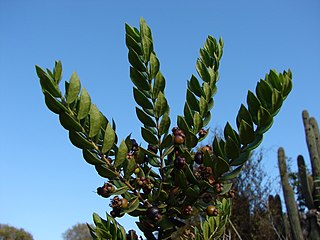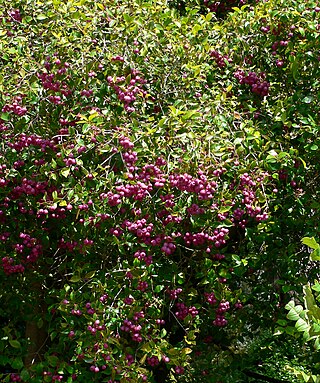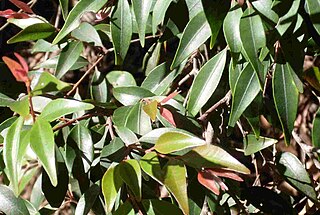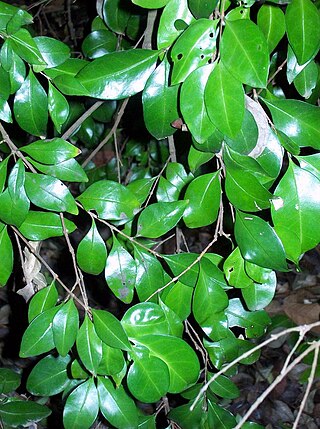
The yellow-rumped warbler is a regular North American bird species that can be commonly observed all across the continent. Its extensive distribution range connects both the Pacific and Atlantic coasts of the U.S. as well as Canada and Central America, with the population concentrating in the continent's northern parts during the breeding season and migrating southwards to southern North and Central America in Winter. The species generally prefers coniferous forests or mixed coniferous-deciduous forests as its breeding habitat, while during the winter it can be found inhabiting more open areas such as shrublands that offer food resources. The diet of the yellow-rumped warbler is based primarily on insects, though the species does eat fruits such as juniper berries as well, especially in winter.

Myrtus is a genus of flowering plants in the family Myrtaceae. It was first described by Swedish botanist Linnaeus in 1753.

Luma apiculata, the Chilean myrtle or temu, is a species of flowering plant in the myrtle family, native to the central Andes between Chile and Argentina, at 33 to 45° south latitude. Growing to 10–15 m (33–49 ft) tall and wide, it is a vigorous, bushy, evergreen tree with fragrant flowers.

Nothofagus cunninghamii, commonly known as myrtle beech or Tasmanian myrtle, is the dominant species of cool temperate rainforests in Tasmania and Southern Victoria. It has low fire resistance and grows best in partial shade conditions.

Luma chequen, the white Chilean myrtle, is a species of flowering plant in the genus Luma in the family Myrtaceae, native to the central Andes mountains between Chile and Argentina, at latitudes located 30 to 41° South. Synonyms include Eugenia chequen Molina, Myrtus chequen (Molina) Spreng., and Luma gayana (Barn.) Burret. Common names in Spanish include chequén, huillipeta, and arrayán blanco.

Myrica californica is an evergreen shrub or small tree native to the Pacific Ocean coast of North America from Vancouver Island south to California as far south as the Long Beach area.

Syzygium smithii is a summer-flowering, winter-fruiting evergreen tree, native to Australia and belonging to the myrtle family Myrtaceae. It shares the common name "lilly pilly" with several other plants.It is planted as shrubs or hedgerows, and features: rough, woody bark; cream and green smooth, waxy leaves; flushes of pink new growth; and white to maroon edible berries. Unpruned, it will grow about 3–5 m (9.8–16.4 ft) tall in the garden.

Syzygium paniculatum, the magenta lilly pilly or magenta cherry, is a species of flowering plant in the myrtle family Myrtaceae, native to New South Wales, Australia. A broad dense bushy rainforest tree, in cultivation it grows to a height of 15 m (49 ft) with a trunk diameter up to 35 cm (14 in). The largest known example is at Ourimbah Creek, 35 m (115 ft) metres tall. The leaves are 3–9 cm (1.2–3.5 in) long, opposite, simple and slightly obovate, tapering at the leaf base. They are dark glossy green above, and paler below. White flowers are produced in clusters. The edible fruit is usually magenta, but can be white, pink or purple. The seeds are polyembryonic.

Acacia myrtifolia, known colloquially as myrtle wattle, red stem wattle or red-stemmed wattle, is a species of Acacia native to coastal areas of southern and eastern Australia.

Austromyrtus dulcis is a species of plant native to eastern Australia. It grows as a small spreading shrub and is easily recognised by its characteristic berries that usually ripen in summer and autumn. Common names include the midgen berry, midyim, and silky myrtle.

Syzygium moorei is a rare sub tropical rainforest tree, growing on volcanic soils in the Mount Warning area of north east New South Wales and south east Queensland, Australia. Common names include coolamon, watermelon tree, durobby and robby; it is also called "rose apple" but this can refer to many species of Syzygium.

Uromyrtus australis, commonly known as the peach myrtle, is a small tree growing around Nightcap National Park, New South Wales, Australia. It is endangered by extinction. The delicate foliage, pink flowers and appealing fruit makes this a particularly beautiful tree.

Gossia bidwillii, known as the python tree is a rainforest myrtle of eastern Australia. The usual habitat is the drier rainforest areas. The range of natural distribution is from the Hunter River in New South Wales to Coen in far northern Queensland.

Syzygium hodgkinsoniae is a rare subtropical rainforest tree, growing on alluvial soils by streams in the north east New South Wales and south east Queensland, Australia. The range of natural distribution is from the Richmond River, New South Wales to Gympie in south east Queensland. Common names include smooth-bark rose apple or red lilly pilly.

Rhodomyrtus psidioides, the native guava, is a shrub or small rainforest tree up to 12 m (39 ft) high, member of the botanical family Myrtaceae, native to eastern Australia.

Styphelia humifusa, commonly known as native cranberry or cranberry heath, is a small prostrate shrub or groundcover in the heath family Ericaceae. The species is endemic to south-eastern Australia.

Decaspermum humile, commonly known as the silky myrtle, is a tree from Australia and Asia. It can be used as bush food, as indicated by the alternate common name of currant myrtle. The tree features an attractive dark glossy crown. The new pink leaves with silvery hairs are particularly appealing.

Uromyrtus lamingtonensis is a rare Australian shrub growing around the state border of New South Wales and Queensland. Like the Peach Myrtle, it has attractive pink flowers.

Gossia fragrantissima, the sweet myrtle or small-leaved myrtle, is a shrub or small tree of eastern Australia. A plant with a ROTAP rating of 3EC-, endangered by extinction. Found in sub tropical rainforests near streams, from near Woodburn, New South Wales to Nambour in south eastern Queensland. It features fragrant flowers, hence the specific epithet fragrantissima. White flowers grow from October to February.

Pilidiostigma glabrum, the plum myrtle, is a small tree or shrub native to the rainforests of eastern Australia. Commonly seen in disturbed sites from near Port Macquarie in the south to Fraser Island in the north.



















